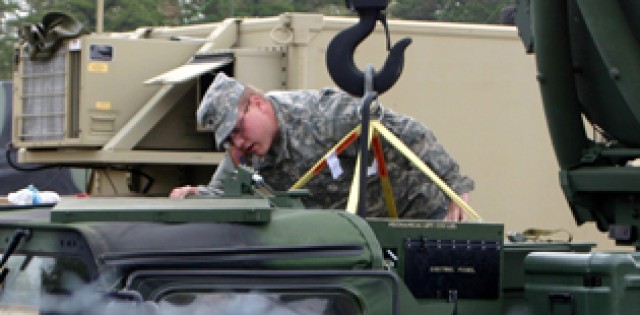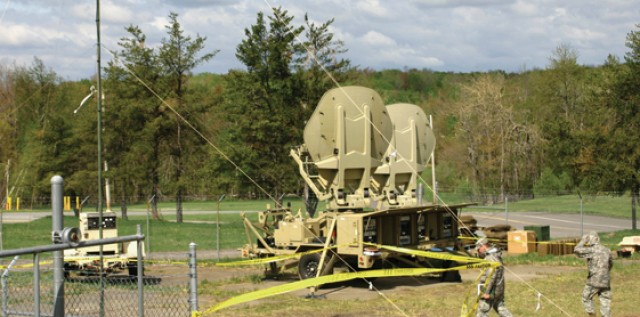TOBYHANNA ARMY DEPOT, Pa. - (Editor's note: This is a follow-up article to "Guard unit finds home at Tobyhanna," printed in the June 16 issue of The Tobyhanna Reporter.)
On May 2, Soldiers from the 55th Brigade Combat Team's Special Troops Battalion, Company B, set foot on Tobyhanna soil with aspirations of making the next two weeks the best annual training exercises.
This event marked the first time a Pennsylvania Army National Guard (PAARNG) unit held annual training (AT) at the depot.
The unit, which is a Command, Control, Communications, Computers, Intelligence, Surveillance and Reconnaissance signal systems network support company, works with joint node networks (JNN)- a shelter linked with a KU band satellite. The KU accesses a commercial satellite orbiting the Earth and transmits information to/from the JNN, which provides the unit, and the unit it supports, with voice services and internet connectivity. They also work with the Secure Mobile Anti-Jam Reliable Tactical (Satellite) Terminal (SMART-T).
"[The Soldiers performed] a very big exercise," noted unit commander Capt. James Minicozzi, explaining that KU satellite dishes were placed throughout the installation, one by Building 230 (the barracks) and two by "tent city" (near the Post Exchange). The SMART-T was also located in tent city.
Company B created a state-wide network with other units at forts Indiantown Gap and Gordon, Ga., and Chippewa, by using command post nodes to pass Internet, voice over Internet protocol, Defense Switched Network (DSN) access and video teleconferencing.
Brig. Gen. James R. Joseph, assistant division commander for the PAARNG's 28th Infantry Division, visited Tobyhanna the day the unit held a video teleconference that simulated communication between Iraq and Afghanistan.
"That's exactly what that kind of technology would be used for," Minicozzi explains. "The general came here that day because he wanted to see this technology being used, and how we were able to use our phone services." Joseph made commercial and DSN calls to people's cell phones and was "gee-whizzed by all of this."
Part of the unit's AT included an on-post exercise using Blue Force Tracking (BFT), which allows Soldiers in the field to see where they are via maps displayed on video monitors mounted in their Humvee. Soldiers and commanders can communicate with each other through radio and satellite e-mail, which also provides global positioning information.
During the exercise, Soldiers traveled around the depot while Minicozzi watched on the screen located in Building 230. Troops eventually traveled outside the depot to Legihton, Scranton and Fort Indiantown Gap, marking points along the way. As they marked the points, they appeared in real-time on the screens in Building 230.
The exercise simulated real-life situations, such as encountering an improvised explosive device.
"This allows [troops] to report to the command post through a computer inside their Humvee, and what they're seeing and hearing is displayed back at the command post," Minicozzi says. "They can also share what they just encountered so other units can avoid [problems]."
By holding the annual training (AT) here, PAARNG leadership was able to see great training, and a partnership between the unit and the depot occurring, says Sgt. Raymond Naperkowski, who helped provide essentials such as fuel and food for the operation.
"We didn't have any issues," Minicozzi notes. He believes the success of the training showed members of the PAARNG that setting up shop at Tobyhanna was a good choice.
"There were generals and colonels coming here and they were impressed with what we were doing in such a short amount of time," Spc. Paul Welby said, adding the Soldiers were commended for their SMART-T and BFT exercises.
Depot employees were invited to see the systems in use during the unit's AT.
"It's kind of neat, especially since our unit is from this area, because we understand how instrumental Tobyhanna is to the warfighter and to the war in Iraq," Minicozzi explains, adding that one of the reasons for moving the unit here is because the depot works with the same type of equipment that the unit uses.
Minicozzi said he recognizes that depot employees fix and refit the equipment, send it to the Soldier and don't see it after that, and believes the experience brought to life the job of Tobyhanna employees.
"One of the agreements that I've made with the individuals at Tobyhanna is that whenever we do exercises here, about every other month, we will invite the work force over to watch us using the equipment," Minicozzi says.
The captain already has plans for the future, noting "one of the key things I would like to see is us working jointly with Tobyhanna's work force."
His plans stem from participation in a recent deployment that allowed him to work with depot personnel.
Another positive aspect of being at Tobyhanna is that Soldiers were more mission-focused, meaning that they were able to concentrate only on signal missions.
"When we go to other bases [for AT] we have warrior tasks to do, such as hand-grenade and M-16 ranges," Naperkowski explains. "You have to plan around them, but this AT was totally mission-focused."
When the unit goes to other installations, there are a lot of infantry and tanker combat arms there, Minicozzi says, noting that they might not understand a signal unit's needs.
"Here we start talking SMART-T, KUs or different components of that, and people at the depot understand us."
"If we were somewhere else we wouldn't have been able to accomplish what we did during our AT. By being here, we were able to stay focused on the mission and not deviate in any other direction," Minicozzi explains.
During the training, the unit called upon depot technicians to assist because a laptop on the unit's SMART-T stopped working. A depot employee who was observing provided a laptop from Tobyhanna until the Soldier's new one arrived.
"If we were anywhere else then that would have hurt the mission," Welby noted.
The captain and the troops agree that the move to Tobyhanna will be beneficial for the unit as well as the depot.
"I think we're starting off on the right foot; we're going to have a lot of other firsts with Tobyhanna, especially with the civilian force," Naperkowski said.
Tobyhanna Army Depot is the Defense Department's largest center for the repair, overhaul and fabrication of a wide variety of electronics systems and components, from tactical field radios to the ground terminals for the defense satellite communications network. Tobyhanna's missions support all branches of the Armed Forces.
About 5,600 personnel are employed at Tobyhanna, which is located in the Pocono Mountains of northeastern Pennsylvania.
Tobyhanna Army Depot is part of the U.S. Army CECOM Life Cycle Management Command. Headquartered at Fort Monmouth, N.J., the command's mission is to research, develop, acquire, field and sustain communications, command, control computer, intelligence, electronic warfare and sensors capabilities for the Armed Forces.






Social Sharing